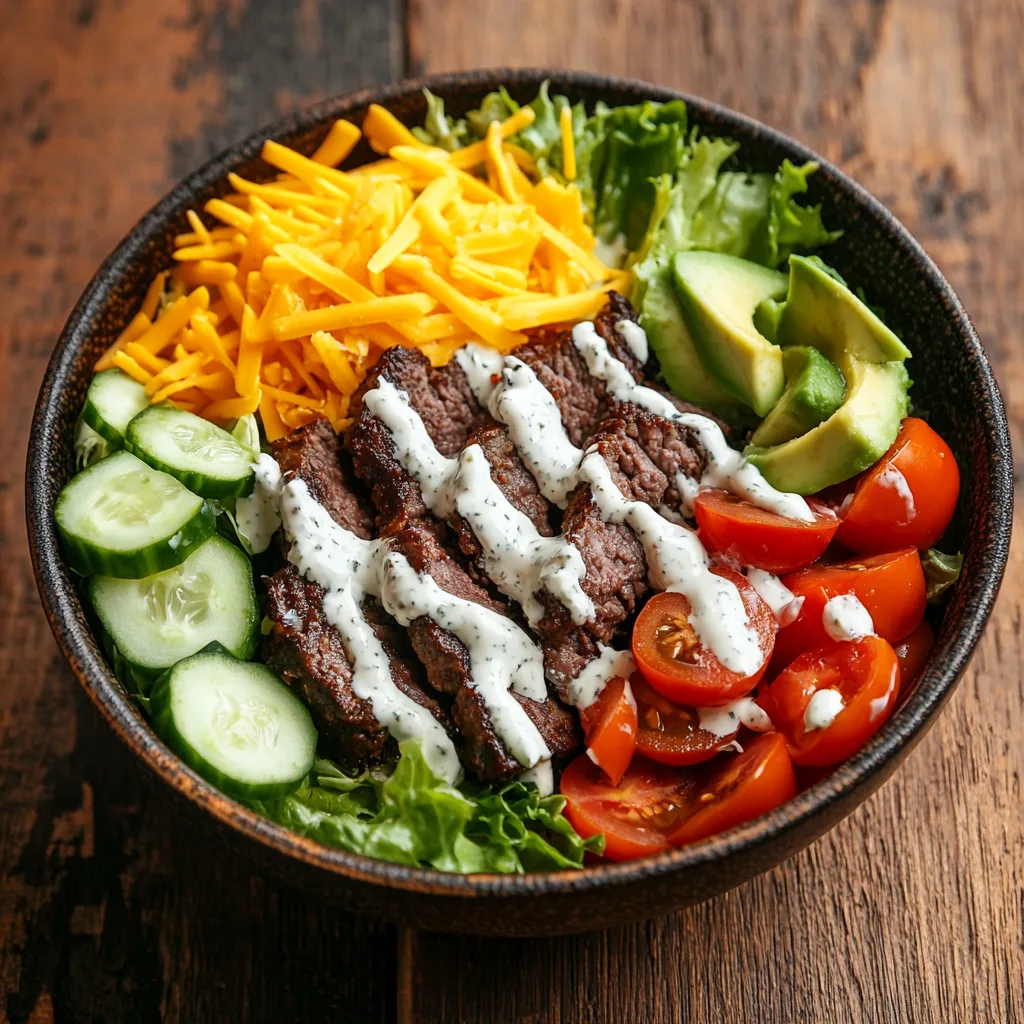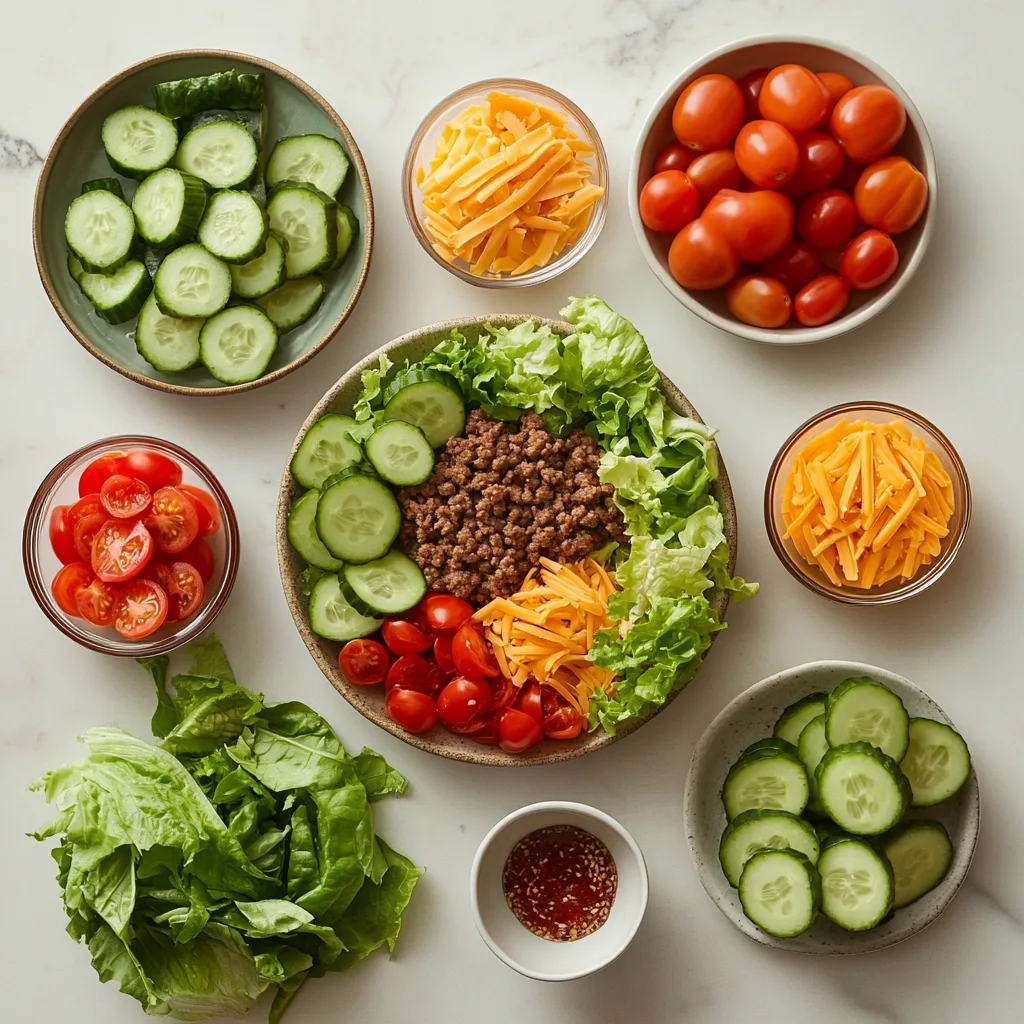
Introduction to Burger Bowl Recipe
A burger bowl takes everything you love about a classic burger—juicy protein, crisp veggies, and mouthwatering toppings—and serves it in a fresh, bun-free way. This deconstructed burger is a healthier, more versatile option that lets you enjoy bold flavors without the extra carbs.
Let’s dive into the ultimate burger bowl recipe, packed with flavor, crunch, and wholesome ingredients!
Ingredients You’ll Need for the Ultimate Burger Bowl Recipe

Creating the perfect burger bowl starts with the right ingredients. Here’s what you’ll need to prepare a flavorful and satisfying meal:
Protein Options
The protein is the star of your burger bowl. Choose your favorite based on your preferences or dietary needs:
- Ground beef: Use lean or grass-fed beef for a classic burger taste.
- Chicken or turkey: A leaner option that’s lighter but still flavorful.
- Plant-based alternatives: Great for vegans and vegetarians; try options like Beyond Meat, black bean patties, or lentil-based crumbles.
Fresh Vegetables
Vegetables add texture, flavor, and nutrients to your burger bowl. Include a mix of these:
- Greens: Lettuce, spinach, kale, or arugula make a great base.
- Crisp veggies: Cherry tomatoes, cucumbers, carrots, and bell peppers add crunch and freshness.
- Grilled or sautéed options: Onions, zucchini, or mushrooms provide a smoky, savory touch.
Toppings and Extras
Elevate your burger bowl with the following toppings:
- Cheese: Shredded cheddar, feta, or a dairy-free alternative.
- Pickles: Dill pickles or pickled onions for a tangy bite.
- Avocado: Adds creaminess and healthy fats.
- Sauces: Classic choices like ketchup, mustard, or ranch dressing, or get creative with spicy mayo or tzatziki.
- Grains (optional): Add quinoa, brown rice, or couscous for extra heartiness if you’re not going low-carb.
Step-by-Step Guide to Making a Burger Bowl
Here’s how to prepare a burger bowl that’s both simple and delicious:
Step 1: Prepare the Protein
- Choose your meat or alternative: Opt for ground beef, turkey, chicken, or a plant-based protein.
- Season the protein: Add salt, pepper, garlic powder, onion powder, smoked paprika, or your favorite burger seasoning blend.
- Cook the protein:
- For ground meat, form it into patties or cook it crumbled in a skillet over medium heat until fully browned.
- For plant-based patties, follow package instructions and pan-sear or bake.
Tip: Let your patties rest for a few minutes before slicing to retain their juices.
Step 2: Build the Base
- Choose your greens: Start with a layer of fresh lettuce, spinach, or kale.
- Add a grain (optional): If you prefer a heartier bowl, layer in quinoa, couscous, or rice.
Tip: For a low-carb option, stick with greens only or use cauliflower rice.
Step 3: Add Fresh and Vibrant Veggies
- Layer in tomatoes: Use cherry tomatoes or diced Roma for a juicy touch.
- Include crunchy vegetables: Cucumber slices, shredded carrots, or diced bell peppers work well.
- Top with grilled veggies: Sautéed onions, mushrooms, or zucchini add depth of flavor.
Tip: Balance fresh and grilled veggies for a mix of textures.
Step 4: Elevate with Toppings
- Add cheese: Sprinkle shredded cheddar, feta crumbles, or skip it for a dairy-free version.
- Include avocado slices or a dollop of guacamole for creaminess.
- Add pickles or pickled onions for tangy contrast.
Step 5: Drizzle on the Sauce
- Classic options include ketchup, mustard, or ranch dressing.
- Creative alternatives like chipotle mayo, tzatziki, or a balsamic glaze can take your bowl to the next level.
Tip: Drizzle lightly to avoid overpowering the flavors of the fresh ingredients.
Step 6: Serve and Enjoy
Your burger bowl is ready to eat! Serve immediately to enjoy the freshest flavors.
Popular Burger Bowl Variations to Try
Burger bowls are incredibly versatile, as they allow you to customize them effortlessly for different diets, tastes, or occasions. For instance, you can tailor a burger bowl to fit a keto lifestyle, a vegan preference, or even a Mediterranean-inspired palate. Here are some popular variations you might want to try:
Keto-Friendly Burger Bowl
Perfect for low-carb enthusiasts, this variation focuses on healthy fats and protein while cutting out carbs:
- Base: A mix of romaine lettuce, spinach, and arugula.
- Protein: Grass-fed beef patty or crumbled beef cooked with keto-friendly seasonings.
- Toppings: Avocado slices, shredded cheddar cheese, crispy bacon, and pickles.
- Sauce: A drizzle of garlic aioli or sugar-free ranch dressing.
Tip: Swap ketchup for a sugar-free version or skip it altogether to stay within your carb goals.
Vegan Burger Bowl
For a plant-based twist, this variation is packed with wholesome ingredients:
- Base: Baby spinach or mixed greens.
- Protein: Black bean or lentil-based patties, tempeh, or crumbled tofu seasoned with smoked paprika and cumin.
- Toppings: Sliced cherry tomatoes, shredded carrots, cucumbers, grilled zucchini, and avocado.
- Sauce: Dairy-free chipotle mayo or tahini dressing.
Tip: Add a sprinkle of nutritional yeast for a cheesy, umami flavor without dairy.
Loaded Classic Burger Bowl
This variation is for those who love the traditional burger experience, just without the bun:
- Base: Chopped iceberg or romaine lettuce for crunch.
- Protein: A juicy beef patty or turkey patty.
- Toppings: Sliced onions (grilled or raw), diced tomatoes, shredded cheddar cheese, crumbled bacon, and pickles.
- Sauce: Ketchup, mustard, and a drizzle of creamy thousand island dressing.
Tip: Add crispy onion straws or roasted potatoes for an indulgent twist.
Mediterranean Burger Bowl
Infused with Mediterranean flavors, this version offers a refreshing change:
- Base: A mix of arugula and romaine lettuce.
- Protein: Lamb burger patty or ground turkey seasoned with oregano, garlic, and lemon zest.
- Toppings: Cherry tomatoes, sliced cucumber, kalamata olives, and crumbled feta cheese.
- Sauce: A generous dollop of tzatziki or hummus.
Tip: Sprinkle with fresh dill or parsley for an extra burst of flavor.
Southwest Burger Bowl
Bring a bold, Tex-Mex flavor to your burger bowl with this variation:
- Base: A bed of shredded lettuce or mixed greens.
- Protein: Seasoned ground beef or blackened chicken.
- Toppings: Grilled corn, black beans, diced tomatoes, sliced jalapeños, and shredded pepper jack cheese.
- Sauce: Spicy chipotle mayo or avocado lime crema.
Tip: Add crushed tortilla chips for a satisfying crunch.
Each of these variations offers a unique flavor profile while staying true to the burger bowl concept. Experiment with different combinations to find your favorite!
Tips for Meal Prep and Storage of Burger Bowls
Burger bowls are a fantastic option for meal prepping because their ingredients can be prepared in advance and easily assembled when needed. Here are some tips to keep your burger bowls fresh and flavorful throughout the week:
1. Prep Ingredients Separately
To maintain freshness and prevent sogginess:
- Protein: Cook your meat or plant-based protein ahead of time, and store it in an airtight container in the fridge.
- Vegetables: Wash and chop fresh vegetables like lettuce, tomatoes, and cucumbers, but keep them stored separately in airtight containers.
- Toppings and Sauces: Store cheese, pickles, avocados, and sauces in individual containers to add when ready to eat.
Tip: Squeeze lemon or lime juice over avocados to keep them from browning.
2. Use Divided Containers
For a quick grab-and-go option, use meal prep containers with compartments.
- Keep wet ingredients like sauces and dressings separate from dry ingredients until just before eating.
- Add greens and veggies in one section, protein in another, and toppings or grains in a third.
Tip: Store dressings in small, leak-proof containers to avoid spills.
3. Choose Long-Lasting Ingredients
Some ingredients stay fresher longer than others. When meal prepping for the week, opt for:
- Sturdy greens: Kale or romaine lasts longer than delicate greens like arugula.
- Pre-cooked grains: Quinoa and brown rice hold up well over several days.
- Grilled veggies: Zucchini, mushrooms, and onions taste great even after reheating.
Tip: Avoid adding watery vegetables like cucumbers if storing for more than 2 days, as they can release moisture and make the bowl soggy.
4. Reheat Protein Carefully
When ready to eat, reheat cooked protein gently to preserve its flavor and texture:
- Use a microwave at 50% power to avoid drying out the meat.
- Alternatively, warm it in a skillet with a splash of water or broth for extra moisture.
Tip: If you’re enjoying a cold bowl, no need to reheat—just assemble and serve!
5. Storing Leftovers
If you have pre-assembled burger bowls, follow these guidelines:
- Keep them refrigerated in an airtight container and consume within 3-4 days.
- Avoid adding dressing until just before eating to keep the greens fresh.
Tip: If you’ve included avocados, store them separately or add them fresh on the day you plan to eat.
Meal prepping burger bowls is a time-saver for busy schedules. With proper storage, you can enjoy a fresh, flavorful, and nutritious meal anytime during the week.
Exploring Further Culinary Delights
If you’re enjoying the freedom and flavor of a burger bowl, you might be curious about other ways to enhance your meals. For those looking to make the healthiest choices, discovering what is the healthiest burger you can make can be a helpful guide. Beyond burgers, understanding what is the secret to soup can elevate your comfort food game, while comparing sourdough bagels vs. regular bagels could influence your breakfast choices. For those embracing plant-based eating, exploring easy and tasty vegan kabocha squash recipes for every cook could broaden your culinary horizons, and if you are craving a warm meal, the taco soup frios recipe offers a different kind of delicious bowl. These diverse culinary avenues provide plenty of opportunity to continue your journey of delicious exploration.
Frequently Asked Questions About Burger Bowl Recipes
1. What is the secret ingredient in a good burger?
The secret ingredient to a flavorful burger or burger bowl lies in the seasoning. A mix of garlic powder, onion powder, smoked paprika, and Worcestershire sauce elevates the taste of any protein, whether beef, chicken, or plant-based. For an extra flavor boost, mix a small amount of Dijon mustard or grated onion into your ground meat before cooking.
2. How much protein is in a burger bowl recipe?
The protein content in a burger bowl depends on the type and portion of protein used:
- Beef (4 oz): About 25 grams of protein.
- Chicken breast (4 oz): Around 31 grams of protein.
- Plant-based options (like black beans or tofu, 4 oz): Typically 10–15 grams of protein.
Adding extras like cheese, eggs, or grains can further increase the protein content. On average, a burger bowl contains 25–40 grams of protein, making it a great option for muscle recovery or staying full longer.
3. What is a deconstructed burger?
A deconstructed burger serves all the components of a traditional burger—patty, vegetables, toppings, and sauces—without assembling them into a sandwich. Instead, they are presented in layers or sections, often on a plate or in a bowl. A burger bowl is essentially a deconstructed burger with added creativity and healthier ingredients like fresh greens.
4. What is the healthiest burger you can make?
The healthiest burger is one that uses high-quality, nutrient-dense ingredients. For a burger bowl recipe, this might include:
- Lean protein: Grass-fed beef, turkey, or plant-based patties.
- Fresh veggies: Greens, tomatoes, cucumbers, and avocado.
- Healthy fats: Olive oil-based dressings or guacamole.
- Low-sodium sauces: Choose mustard, hummus, or Greek yogurt-based dressings over processed options.
This combination provides a balanced meal with fewer calories, more fiber, and healthier fats than a traditional burger with a bun.
